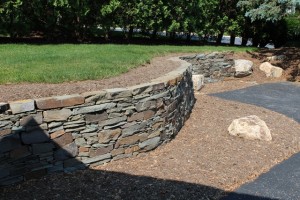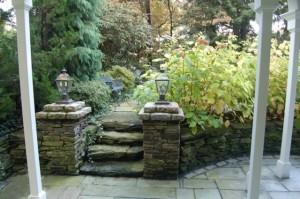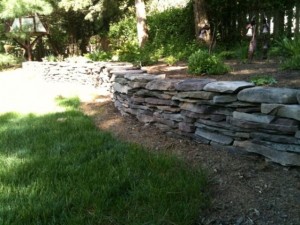 Natural stone walls can add a stunning landscape accent and functional use to a landscape design on many residential and commercial properties. Depending upon your personal preference and the style of your structure, these type of retaining walls can be an excellent choice.
Natural stone walls can add a stunning landscape accent and functional use to a landscape design on many residential and commercial properties. Depending upon your personal preference and the style of your structure, these type of retaining walls can be an excellent choice.
Aesthetic Benefits
Natural stone comes in varieties each ranging in colors, sizes, and textures. Choices vary depending upon what region of the country you are in. Some of the top choices in our area are fieldstone, limestone, and others. These walls look great as they offer irregular shapes to give a natural look in your landscape design.
 When you consult with a landscape designer be sure they explain the cost variations from manufactured retaining walls and even within the grouping of natural walls. Materials can vary in cost so be sure to pick one that fits your budget. Natural stone walls are typically more expensive than manufactured walls. They require more time to fit irregular stones together for a nice look. Still, this classy look may be exactly what is right for your property.
When you consult with a landscape designer be sure they explain the cost variations from manufactured retaining walls and even within the grouping of natural walls. Materials can vary in cost so be sure to pick one that fits your budget. Natural stone walls are typically more expensive than manufactured walls. They require more time to fit irregular stones together for a nice look. Still, this classy look may be exactly what is right for your property.
Functional Benefits
Landscaping companies install natural walls for a variety of functional uses. Retaining walls can be created to create level areas or terraces. At times property owners use natural stone walls to create decorative and functional accents to retain landscape beds. Be sure there is an adequate slope to work with. Installing tall walls on flat terrain will require you to back-fill behind them. This may not be good for plant health around existing trees and shrubs if you add soil on top of their root zones. Be sure to give ample room for tree root growth. Installing a wall too close to the trunk will end up leading to roots pushing and toppling walls in later years.
 Some applications may have a property owner considering adding mortar to secure natural stone walls together. Using mortar will increase maintenance costs as these areas will break and need re-pointed later. A loose-laid natural stone wall will allow for annual movement when seasonal temperature fluctuations will cause the wall to move slightly. Mortared walls could crack when this happens.
Some applications may have a property owner considering adding mortar to secure natural stone walls together. Using mortar will increase maintenance costs as these areas will break and need re-pointed later. A loose-laid natural stone wall will allow for annual movement when seasonal temperature fluctuations will cause the wall to move slightly. Mortared walls could crack when this happens.
Things to Consider
Natural stone walls should not be tall. When possible, try not to exceed 4 feet. The taller the wall, the more potential for leaning or toppling. This is one advantage to manufactured walls as they have lips that help them to interlock.
 When hardscaping elements such as natural stone walls are installed by your landscape contractor, they will dig a small trench where the wall will be installed. A stone base is provided for a firm foundation. The wall is laid to slightly taper back with each layer added. Back-fill of stone aggregate is added immediately behind the wall. This helps with movement and also allows water from behind the wall to not have mud push through. In some instances, a landscape company may also recommend to install drainage pipe behind the wall. This will divert water to other areas so the pressure of heavy rains don’t push out wall stones.
When hardscaping elements such as natural stone walls are installed by your landscape contractor, they will dig a small trench where the wall will be installed. A stone base is provided for a firm foundation. The wall is laid to slightly taper back with each layer added. Back-fill of stone aggregate is added immediately behind the wall. This helps with movement and also allows water from behind the wall to not have mud push through. In some instances, a landscape company may also recommend to install drainage pipe behind the wall. This will divert water to other areas so the pressure of heavy rains don’t push out wall stones.
If you’re considering adding natural stone or manufactured walls on your property, we would love to discuss how our landscaping services could help give your property the wall it deserves. Be sure to check out images of landscaping walls in our gallery.

